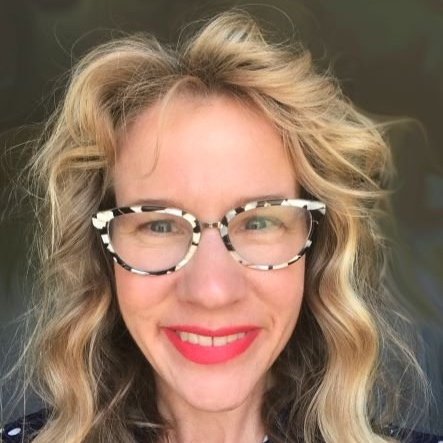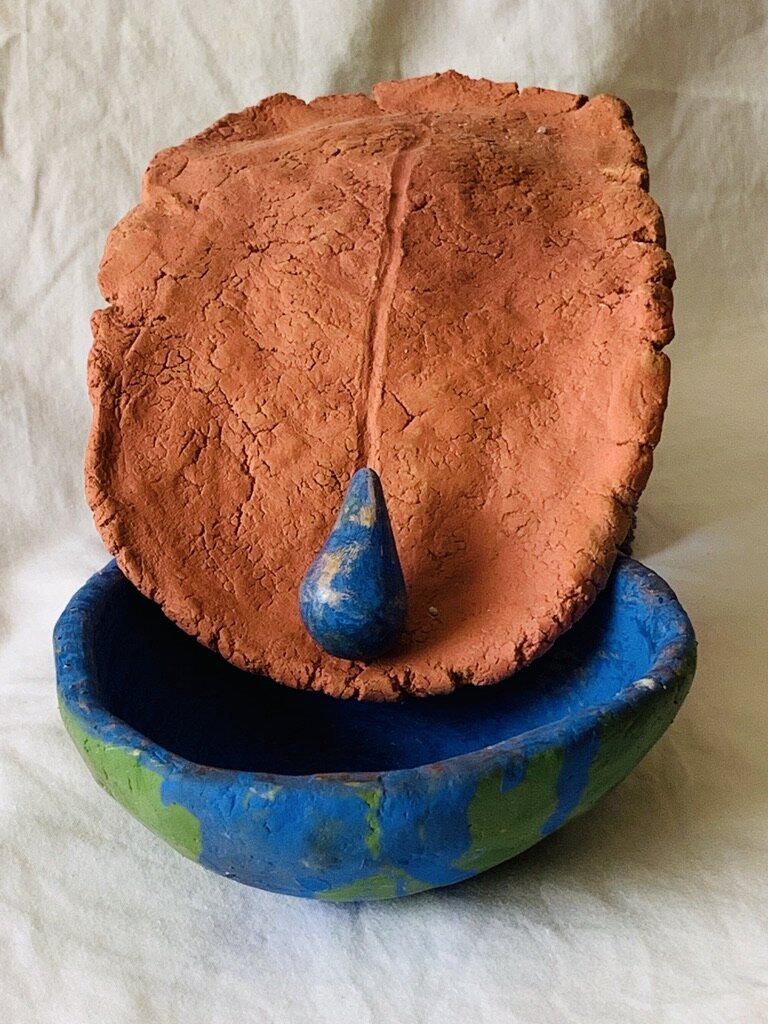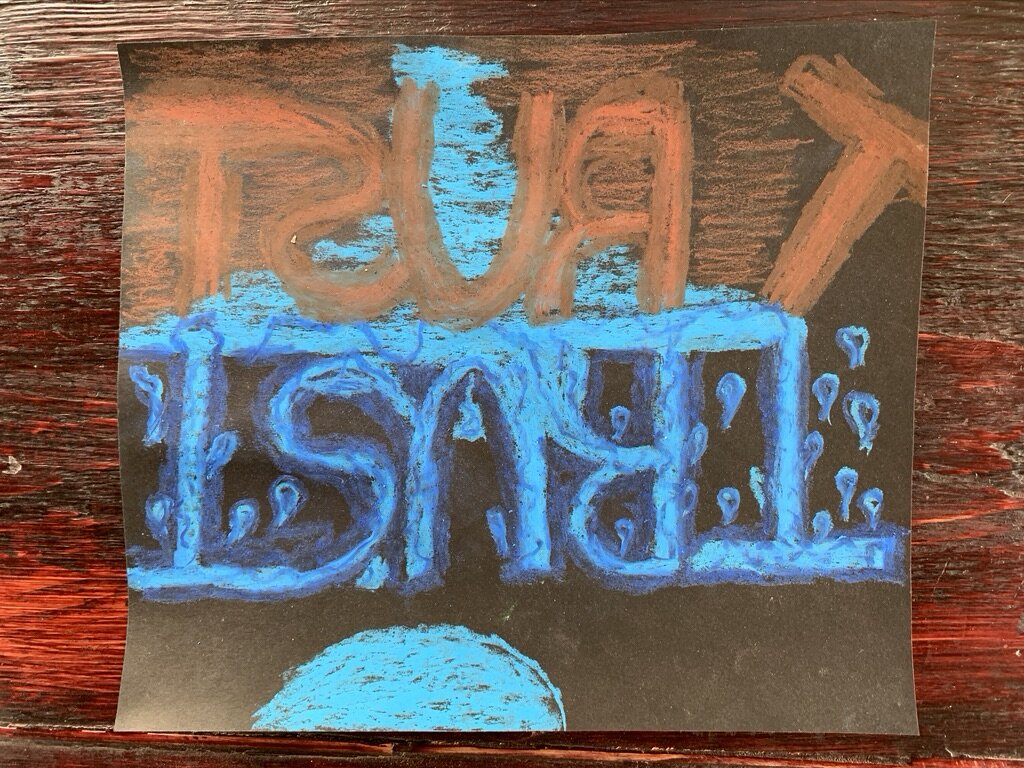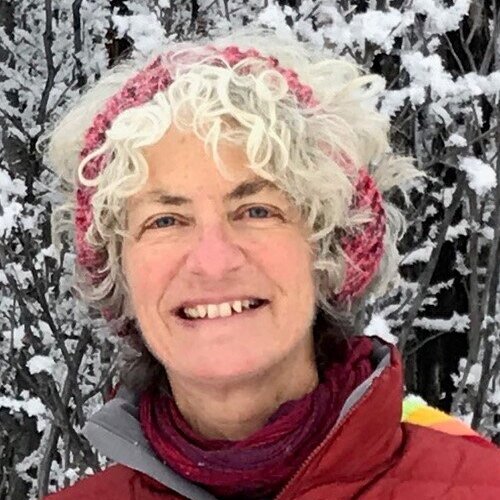


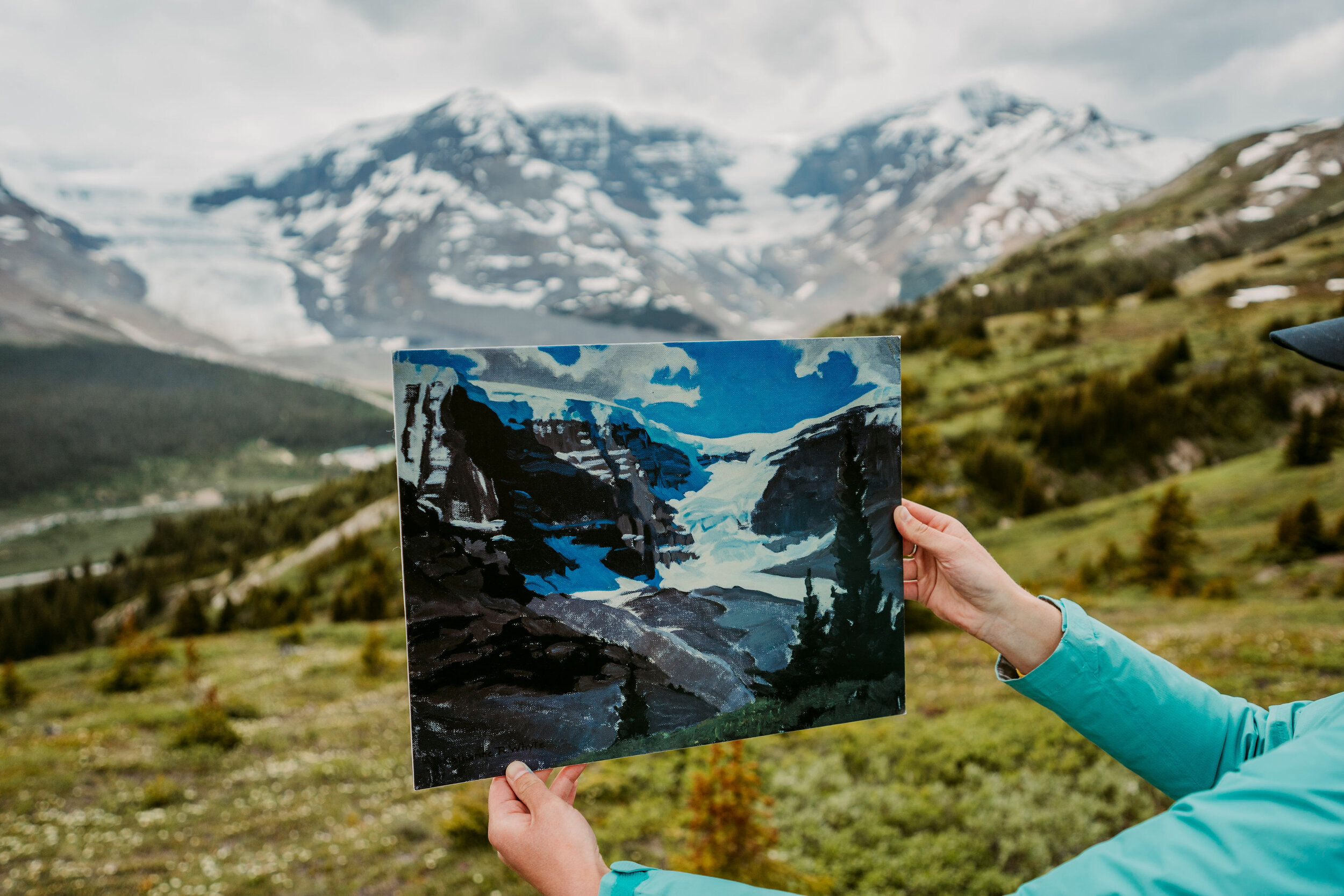

Water You Waiting For
“Water You Waiting For” is a collaborative animated short movie that translates 16 of the most pressing water security issues facing Canada. Scientists associated with the Global Water Futures initiative were interviewed by University of Saskatchewan Bachelor of Fine Arts student Leanne Read and Master of Fine Arts in music student Ricardo Martins who translated what they heard into a digital animation and musical score, under the guidance of professors Lori Bradford (College of Engineering and School of Environment and Sustainability), Dean McNeill (Department of Music), and Lisa Birke (Department of Art & Art History). The animation follows a water drop as it takes us on a journey across Canada to highlight the issues that are bringing the delicate balance of water sustainability to the tipping point but with a resounding chorus of hope.
Read this news article for more information about the project.
Funding was provided by the Global Water Futures Program, and the Global Institute for Water Security at the University of Saskatchewan.
Digital Art/Animation: Leanne Read
Musical score: Ricardo Martins
Supervisors: Lisa Birke, Lori Bradford, Dean McNeill
Voices: Tasman and Aurelia Strickert
Chorus vocals: Luiza Martins
Scientists: Markus Brinkmann, Hayley Carlson, Bob Clark, Grant Ferguson, Tim Jardine, Karl-Erich Lindenschmidt, Matt Lindsay, Merrin Macrae, Simon Papalexiou, Ravi Sel-vaganapathy, Mark Servos, Chris Spence, Tricia Stadnyk, Ron Stewart, and Julie Theriault.
Bios
Lisa Birke is an interdisciplinary artist whose work is a result of the collision of video, performance art, and installation. She is interested in the stories that we re-cite and re-brand and how these inform our conception of the world and the tragi-comic perception of ourselves. Recently, Birke has been exploring immersive multi-media approaches using special effects, AR, and 360 video. Her award-winning video work has seen more than100 screenings and installations at film festivals, media centers and in galleries and museums internationally. Birke is Assistant Professor of Digital and Extended Media and is currently serving as graduate chair in the Department of Art & Art History at the University of Saskatchewan.
Dr. Bradford is an interdisciplinary social scientist in the Ron and Jane Graham School of Professional Development and the School of Environment and Sustainability. Her research focuses on how social and cultural factors get incorporated into technical sciences like hydrology and engineering design.
Dean McNeill is an award winning Canadian trumpet player/composer, proud to call Saskatoon his home for the past 24 years. Dean’s connection to the community includes serving as Head of the University of Saskatchewan Department of Music, member of the Saskatoon Symphony Orchestra, AD of the Saskatoon Jazz Orchestra and running many music education projects & workshops, and leading many of his own professional music ensembles. Dean has been very fortunate to have toured Canada, recorded and/or produced 15 CDs and, he has been a featured guest artist with many Canadian ensembles including the Winnipeg Jazz Orchestra, Calgary Creative Arts Ensemble, Saskatoon Symphony Orchestra, Edmonton Jazz Orchestra, National Youth Band of Canada, and the New Edmonton Wind Ensemble. Dean has received a number of awards, such as the Saskatchewan Jazz Festival’s Special Recognition Award and the Western Canadian Music Award.
From more information visit: https://artsandscience.usask.ca/profile/DMcNeill#/profile
Leanne Read is currently working towards a Bachelor of Fine Arts Honours degree at the University of Saskatchewan. She has developed a passion for animation and digital art. Leanne has recently completed work as a studio production assistant for a multi-media installation called Natures of Reality with professor Lisa Birke. This short film, "Water You Waiting For", has come out of a student scholarship/mentorship summer program in collaboration with the Global Waters Futures initiative to bring awareness of water security issues to the general public. Leanne is the recipient of numerous scholarships and awards from the University of Saskatchewan. She is also a recent awardee of the Prince Edward Arts Scholarship from SK Arts.
Ricardo Martins is a saxophone player and recently graduated with a Bachelor of Music degree from the University of Saskatchewan. He is now working on his Master of Music degree and is scheduled to complete it in April 2023. For over 20 years, Ricardo has dedicated himself to music. He spent over 12 years in Brazil working in television and music production with expertise in audio. He has worked in Europe, South America and the United States, produced over 50 CDs and DVDs and performed for South American audiences with over 90,000 people. More recently, Ricardo has had the pleasure of supporting the Department of Music as Teaching Assistant and was the successful candidate for the Graduate Teaching Fellowship with the Department of Music for 2021-22.
Being Water
Art and Science residency at Anima Casa Rural, St Isidro de Mazatapec, Jalisco, Mexico
In February 2019, Prof. Susan Shantz and Dr. Graham Strickert co-led an invited, art-science residency, Being Water, at ANIMA Casa Rural near Guadalajara, Mexico (February 15 – 26) with travel support from the University of Saskatchewan Global Ambassador Fund. Their host artist, Julian Calleros, had scheduled several field trips, presentations and meetings with local community water experts prior to their arrival; these travel days alternated with workdays in the studio at Anima Casa Rural responding with art to what they were learning.
“This was the first time I’ve ever seen Mexico despite five previous visits to the country. The Being Water Residency at Casa Anima-Rural was transformational. The setting of Casa Anima- Rural is striking; a small permaculture farm that is transforming a desert cactus farm into lush food forest. Casa Anima-Rural is juxtaposed to the miles and miles of green houses, pharmaceutical facilities, bottling plants, cattle operations, cane fields, industrial-scale chicken farms, and walled estates. Meeting with artists, scientists, and activists in this setting was immersive. The discussions we had, the stories we heard and shared, and the places and things we saw through the eyes of water changed me forever. We humans are water, but for our species it is hard to live that truth. I’m committed to learning how we can live that truth.” -Graham Strickert
“Attending the Becoming Water Artist Residency was an invaluable experience for me, because it allowed me to connect with people who care for water and artistically express my reflections. During the time at the residency, I had the chance to have meaningful conversations around water with the participants and some of the local advocates around water concerns. These conversations combined with well-designed site visits opened space for reflection and resulted as works of poetry, pottery as well as collaborative art work produced with the participants. My attendance also set the foundation for making my first film for water, I am River, which can now be seen at the Shaw Community Link.” - Serap Brown
Art Pieces
Below are some of the art pieces created during this residency.
Susan Shantz and Graham Strickert also collaborated on the creation of an interdisciplinary course, “Becoming Water”, to connect science with art to deepen students’ awareness of key issues related to water. Have a look at the “Becoming Water/Ser Agua" film.
Find out more about the Colectivo Mazatepec on Facebook: https://www.facebook.com/vallemazatepec; https://www.facebook.com/ColectivoMazatepec0; https://www.facebook.com/Centro-de-Acopio-Mazatepec-105542144251516
Bios
Mr. Jorge Guzman is a film maker from San Isidro de Mazatapec, Mexico. He is a member of the San Isidro Collective. He has organized the collective of young people ages 12 – 40 and their activities in the area of culture (an annual festival in 3 valley towns where they seek to expand the range of cultural forms and issues being presented publicly: education (annual camps for young people in the country where they learn environmental perspectives on nature) and ecology (learning about the ecological zones in the valley: plains, forest, hills and perimeter areas).
Ms. Gabriela García-Luna is a photo-based artist born in Mexico City, living in Canada, and traveling to India since 2000. Since 1999 García-Luna has experimented using photography in her work in a wide range of forms. Her photographic, drawing and installation work are the result of the subjects chosen by her transitory personal experiences in combination with her constant enquiry about the nature of perception and concepts of reality. Her work elicits a hybrid visual language in constant evolution. www.gabrielagarcialuna.com
Dr. Graham Strickert is an assistant professor in the School of Environment and Sustainability at University of Saskatchewan. His research focuses on the human dimensions of Water Security. In particular he is interested in how humans’ values influence their use of different kinds of evidence in decision making about water. Graham has worked a lot on the problem of how to communicate evidence from water sciences with a wide range of audiences, which lead him to many collaborations with artists and scientists such as: Downstream- Performing Perspectives about Water Security with Greystone Theatre; the Delta-Display: a mixed-media interactive travelling art exhibition to celebrate Canada’s large in-land river deltas; and he has worked on a variety of film projects to showcase place-based water research programs.
Mr. Joaquin Flores is a member of the San Isidro Collective whose life was changed by the culture Camp he attended with Mr. Guzman as a teenager. It led him to study environmental engineering at ITESO University (Universidad Jesuita De Guadalajara). Flores worked with Guzman in activism and a film to protect the drinking water sources at Ahuiscolco from potential contamination when molasses waste pits were proposed directly above their water source.
Julian Calleros is the Director of ANIMA Casa Rural and the main point person during the residency. His love for the arts and culinary creativity have led him to the creation of many different projects such as Naco Gallery, Knaves Kitchen and now ANIMA Casa Rural Artist Residency. Julian Calleros revisits his historical, social and political interests in all his projects to consider how we can look at food, art, community and collaboration.
Serap Brown is a water lover. Her love and care for water led her write poetry, bicycle along rivers from source to sea, create the website River Riders and produce the film, I am River. She aims to combine art and science together for water in her work to offer space for reflection on our relations to water. Serap is currently studying towards her PhD at the University of Victoria and aims to contribute to environmental education.
Prof. Susan Shantz is Professor of Studio Art in the Department of Art and Art History at the University of Saskatchewan where she teaches sculpture and multi-media studio practices. She has led several collaborative, interdisciplinary art projects with students and the Saskatoon Tribal Council and the School of the Environment and Sustainability. Her teaching and artwork involve a variety of media, often sculptural in form, that explore embodied ways of knowing. She is interested in ritual and gesture, and the ways in which art arises from these and becomes a cultural performance. She holds a M.F.A. in Sculpture/Interdisciplinary Art (York), a M.A. (with Distinction) in Religion and Culture (Wilfrid Laurier) and a B.A. in English Literature (Goshen College, Indiana).
Grand Expressions
Grand Expressions is a project that integrates perspectives shared by Six Nations youth with perspectives shared by subject matter experts, water managers and other members of the public. Together, lessons gleaned from conventional research approaches are intertwined with lessons highlighted in the stories told by the youth. Perhaps this project - and the visual and written stories that are a part of it - will remind us that our future depends on prompt, collective action regarding one shared resource: water.
Art pieces
You can view the full exhibit booklet at www.granderiestudy.ca/tour
Convers ACTION by KMC Miler
Two Points of the Problem (top: melting ice caps, bottom: drought), Paddle, by Steve Johnson and Tayler Hill
Energy Footprint (Series: Drinking water) by KMC Miller
Two Sisters, Drum, by Thomas H. Anderson
Water Keeper (Series: MMIWG) by Ashley Cattrysse
Our Timer by Ashley Cattrysse
Bio
Elaine Ho is a PhD Candidate in Social and Ecological Sustainability (Collaborative Water Program) at the University of Waterloo, and is part of Global Water Futures-Lake Futures. In her work, she considers ways to improve fresh water monitoring and management in Southern Ontario’s largest watershed through public and Indigenous engagement processes. As part of this research, she collaborated with Indigenous youth from Six Nations of the Grand River to co-create Grand Expressions, a virtual art exhibit with accompanying stories to highlight the youths’ relationships with water. In 2019, Elaine’s collaborative research won the “Our Water – Our Life – Most Valuable Resource” award from the Canadian Water Resources Association. In 2020, Elaine and her research were nominated for 2021 Clean50 awards in the Emerging Leaders and Project categories.
Nameless Streams
In southern Ontario, streams that flow year-round usually have names and appear on maps. We measure their flows, test their water quality, include them in our models, and develop plans and policies to protect them. These are signs of the importance we give to these permanent water bodies. In contrast, temporary streams that flow occasionally during the year are nameless, and rarely appear on maps. As a result, they receive vastly less attention from water scientists and managers than their permanent cousins. Even though they only flow in spring, or after heavy rains, ephemeral and intermittent streams are a vital part of the water cycle in southern Ontario. Like the tiniest blood vessels in the body, they are small but integral parts of much larger systems. They provide habitat for plants and animals, and supply water, sediments, nutrients and organic matter to downstream areas.
Protecting ephemeral and intermittent streams is important to ensure they can provide these important functions - but to protect them, we first need to know they exist, and we need to care about them. Drawing on scientific knowledge about their flow, the appearance of banks and bottoms, and the types of vegetation and aquatic invertebrates that are found in permanent and temporary streams, we can help ordinary people out for a hike in the forest learn to see temporary streams, perhaps for the first time. Seeing and understanding ephemeral and intermittent streams is the foundation for caring about them enough to protect them.
“My ‘Nameless streams’ project was a proof of concept project. In the next few years, I’m going to develop similar projects in collaboration with partners in watershed management organizations, communities, civil society groups, and universities. However, through initial discussions in early 2020 with prospective collaborators, it became clear to me that people needed a concrete example of the ways in which art and science can be brought together around water issues through photography. Words alone were inadequate; people needed pictures. Thus, in ‘Nameless streams’, I worked both sides of the art-science interface. In future projects, I will rely much more heavily on my partners to bring the scientific perspective to the collaboration.” - Rob de Loë
Collaborative approaches to joining art and science serve a real need that goes far beyond simply science communication. People working in the water field often come to realize that most of the problems we deal with would be a lot easier to solve if more people understood how water works, and why water so important to human and natural systems. My colleague Bill Blomquist, a scholar of water governance, captured the challenge while giving me some feedback on the project:
“I especially loved Nameless Streams. It has a great message (and great photos!) plus a wonderful lesson in humans’ interaction with the rest of the world. The world doesn’t present itself to us pre‐packaged and labeled (“these things are streams”). What counts as a stream largely depends on us.” - Bill Blomquist
Unfortunately, the solution isn’t simply to publish the science more widely. Effective science communication definitely helps – but ordinary people are bombarded with similar messaging on a host of topics. Through strong art-science collaboration, I think we can bring people to the science via the art. This won’t work if art’s only role is to provide decoration for scientific results. Instead, we need to lead with art so that we can create emotional connections to water. These emotional connections can be the basis not only for understanding water better, but also for caring more deeply about water – and that caring can be the basis for positive actions.
My work on Nameless streams was supported by the Social Sciences and Humanities Research Council. I would also like to thank the many colleagues who gave me feedback on drafts of the project.
Art pieces
The full project is posted at www.robdeloephotography.com/Works/Nameless-Streams
Crossing (cover image)
Ephemeral stream - Pond during flow
Permanent stream - Vegetation
Permanent stream - Flow
Intermittent stream - Vegetation
Intermittent stream - Flow after rain
Permanent stream - Bank
Intermittent stream - Bank and bottom
Ephemeral stream - Bottom in a dry spell
Bio
Rob de Loë is a professor in the School of Environment, Resources and Sustainability at the University of Waterloo, a founding member of Global Water Futures, and a member of the University of Waterloo Water Institute. During the past three decades, his focus has been on research and teaching in the areas of water management and governance. Black and white photography using analog and digital techniques was personal pursuit. In 2020, he moved art and photography to the foreground in his professional work. In his current practice he explores how photography can be used to bridge art and science. His images are informed by relevant science, but the goal is to engage viewers primarily through an emotional response. Art website: www.robdeloephotography.com
Prairie Water
The Prairie is arguably the most intensively managed landscape in Canada. Each year millions of acres are seeded with annual crops. The climate is semi-arid to sub-humid, and weather is highly variable. Daily air temperatures range from –40°C to +40°C. The landscape is more diverse than the flat plain that is the stereotype. While there are some areas of gentle slopes, much of the region is rolling and hilly, with numerous depressions. In many of these depressions are wetlands. The Prairie Pothole Region is a portion of the Canadian Prairie with numerous wetlands that provide great value for regional water management, but can represent an opportunity cost to agricultural producers. Estimates of total wetland loss in the region range from 40–70%. Wetland loss can enhance some floods and encourage movement of nutrients and pesticides to the region’s lakes. This can increase risk of eutrophication (lake greening) and harmful algal blooms. Wetlands are focal points for groundwater recharge. It is unknown if the removal of so many wetlands reduces the sustainability of water withdrawal from underlying aquifers. The loss of wetland habitat reduces bird abundance, and biodiversity more generally, in the region. Socioeconomic incentives exist to remove some wetlands from the landscape, and decisions to remove or retain wetlands are driven by a complex suite of cultural, economic, and logistical factors. For more information, visit the Global Water Futures Prairie Water webpage.
Prairie Water is fortunate to have collaborations with both Cheryl Buckmaster, and the Men Who Paint group. Men Who Paint have a Summit to Sea project that has nice synergies with the Prairie Water Project and their interests in improving resilience of communities through better understanding and communication about the importance of water resources. Online discussions among Cam, Ken and Prairie Water researchers, and attendance at regional conferences highlighted the complexity of water management in Saskatchewan, and across the Prairie. This includes key unknowns in the function of natural systems in the region, and in understanding human behaviours that can potentially alter these systems. Prior to COVID-19 shutdowns, we were fortunate to have Cheryl attend our 2020 Annual Partners Meeting as a starting point for her piece Water, which featured similar themes. Cheryl describes her process of creating this piece, with accompanying images, below. We hope that we will have the opportunity to gather in-person in the near future to visit field sites, further build these relationships, and to discuss art and science.
Art piece
Cheryl Buckmaster
Water
Ink and Acrylic on Mulberry Paper, 114x107cm
“The imagery of ‘Water’ speaks to the interconnectedness of water and our shared responsibility in protecting it. Symbols and vignettes are displayed on semi-translucent paper, suspended by a piece of driftwood. The depiction evokes the interdependence of humans and the ecosystems they are a part of, as well as the fragility of this relationship and of water itself. At the heart of the piece is a call to action for collaboration in our approach to water management.” - Jared Wolfe
Creating “Water” - narrative from artist Cheryl Buckmaster:
“The commission began publicly, by attending the Prairie water annual conference where I created ink sketches and notes of key concepts based on impactful water and environmental changes, and land-based knowledge. I took photographs to provided references and insights from scientific studies and models. I hung the sketches and notes in my studio. I layered symbolic imagery to give a feel of depth, this also allowed me to strategically place images to convey meaning and connection.”
“I let myself feel my connection to water. I let the information ruminate with and inform my feelings as symbolic images representing water and its current situation came to mind. I sketched these symbolic images. You can see the pencil sketch in the top of the photograph below. Then I began to add the new images to the original ink sketches made at the conference. “The connections between water and the information kept coming, it was complicated, and thus the sketch also became a step-by-step guide as to how to integrate imagery and layers. In total there are 17 pieces of paper layered into this painting.”
“When would the painting be done? How do I finalize this water cycle of never-ending connections?”
“The idea of the boulders atop the legislative buildings - holding knowledge of earth, compiling the weight of our responsibility for water, and laying the issue of water rights full circle is what concluded the imagery of water connections. Using thread, and driftwood from the Saskatchewan River, the painting hung perfectly balanced on one wire. Painting ‘Water’ has been a great honor.”
Bios
Cheryl Buckmaster’s work is comprised mainly of large figurative paintings forming narratives of human experience and spirit. Her work is infused with symbolism, inviting viewers to contemplate the subject before them. Cheryl was one of three contemporary Saskatchewan painters at AKA’s exhibition “Region”. Her “New Sheet Series” was featured at the Mendel Art Gallery exhibition “Articulation: Joined”. Her artwork is represented in collections throughout Canada and the U.S.. Recently, Cheryl’s collaboration with Yellow Quill First Nation and Prairie Water was featured by the David Suzuki Foundation, and this “Water” painting is displayed at the National Hydrology Research Centre, Saskatoon, SK.
Dr. Lori Bradford is an assistant professor in Ron and Jane Graham School of Professional Development. As a social psychologist, Lori studies how decision making is influenced by social and cultural pressures; how people find out about and use scientific results; and how people cope with issues around water, design problems, and environmental change. Lori has worked on collaborative projects that involve Indigenous partners, artists and scientists such as: “Downstream - Performing Perspectives about Water Security” with Greystone Theatre; Delta Ways Remembered - A whiteboard animation project; Spirit, Safety and a Stand-Off Artistic Animation with Yellow Quill First Nation, and the Climate Tactics Online Game with the Montreal Science Center.
Colin Whitfield is an Assistant Professor in the School of Environment and Sustainability and the Global Institute for Water Security at the University of Saskatchewan. He holds a BSc in Environmental Science (Simon Fraser University), and MSc and PhD degrees in Watershed Ecosystems (Trent University). Colin is an environmental scientist with an interest in understanding how pressures from human activities influence water resources and ecosystems, and how we can address these challenges. Colin’s research spans terrestrial to aquatic systems, including investigations of atmospheric pollution, catchment hydrochemistry, nutrient biogeochemistry, and aquatic greenhouse gas dynamics.
Dr. Christopher Spence is a research scientist for Environment and Climate Change Canada in Saskatoon. He holds adjunct professor appointments at the Universities of Saskatchewan and Manitoba. His research focuses on better understanding hydrological and hydrometeorological processes in cold regions for environmental prediction systems and policy development. His field studies are in complex landscapes such as the Canadian Shield and Prairie, as well as the Laurentian Great Lakes. Away from work, he enjoys mountain biking, backpacking, and drumming with the North Saskatchewan Regiment Pipes and Drums.
Jared Wolfe is an aquatic ecologist with an interest in exploring how the interaction among science, policy, and management can establish sustainable water resources. He was the Project Manager for the Prairie Water project from 2017-2021 where he conducted research on prairie watersheds and supported the production of a virtual watershed-based modelling system for the Prairies. He also led project-wide research communication and knowledge mobilization efforts, including organizing the Annual Partners Meeting for the project. You can follow his work on Twitter @JaredWolfe76 and LinkedIn.
Dr. Graham Strickert is an assistant professor in the School of Environment and Sustainability at University of Saskatchewan. His research focuses on the human dimensions of Water Security. In particular he is interested in how humans’ values influence their use of different kinds of evidence in decision making about water. Graham has worked a lot on the problem of how to communicate evidence from water sciences with a wide range of audiences, which lead him to many collaborations with artists and scientists such as: Downstream- Performing Perspectives about Water Security with Greystone Theatre; the Delta-Display: a mixed-media interactive travelling art exhibition to celebrate Canada’s large in-land river deltas; and he has worked on a variety of film projects to showcase place-based water research programs.
Rockies Repeat
Rockies Repeat is a documentary that bears witness to climate change through the eyes of emerging artists. Our collective of emerging female and two-spirit Indigenous and settler artists travel by foot to revisit iconic sites in the Canadian Rockies painted by early Banff artist, Catharine Robb Whyte, to see the same places in new ways a century later.
By 2100, current research projects that glaciers in Western Canada will lose between ~70% to ~90% of their volume by the end of the 21st century. Rockies Repeat aims to draw awareness about this ecological crisis while exploring the cultural impacts of a shifting landscape. We are curious about who are we as mountain peoples without glaciers and what role artists can play in documenting and shaping cultural dialogue at this moment.
Caroline Aubry-Wake, a PhD candidate with Global Water Futures, will be joining us for our 2021 plein air painting field camp to share stories from her research on the Peyto Glacier with the artists and for the documentary.
To follow our journey, visit: rockiesrepeatfilm.com and follow us on Facebook and Instagram! You can also see our teaser trailer for our full documentary that will launch in 2022.
Art pieces
Bios
Sikapinakii low horn is a two-spirited artist from the Siksika First Nation, they graduated from the Alberta University of the Arts In 2019 with a bachelors of fine arts in drawing. They use a variety of mixed mediums to tell the stories of their identity, indigenous experiences, culture, language, and stories told. Their overall practice aims to educate the non-indigenous about the Blackfoot people in hopes that it will create a comfortable setting for all. This is crucial as a young Indigenous as they have an ingrained purpose to tell their story and the stories of their people. Connect with Sikapinakii on Instagram @lowhorn.s
Emily Beaudoin has always been drawn to the mountains. Working mainly with ink and watercolour. The way she sees it, people will only fight to protect the wild places they have a connection to, and if her art inspires even just one person to go outside and want to be a part of the wilderness, she’ll be a happy camper.
Kerry Langlois' current body of work is made up of minimalist landscapes and monochromatic paintings. Working primarily in acrylic and resin on birch panel, she is inspired by the haunting beauty and mysterious nature of our Canadian Landscape.
Ariel Hill of AKH Studios is an Indigenous artist hailing from the Six Nations and Wiikwemkoong First Nations. Ariel works primarily in glass blowing and her work is a reflection of the intersection between elements of the natural world and how it relates to human experience. She holds a jewelry certificate from the Kootenay School of the Arts and a Bachelor of Fine Arts degree from the Alberta University of the Arts with a major in Glass. Hill is represented by Gallery Merrick (Nanaimo, BC), Project A (Canmore, AB), Guildworks (Bloomfield, ON) and Art First! (Revelstoke, BC). Connect with Ariel on Instagram @akh_studios
Cheyenne Ozînjâ θîhâ is an artist from the Stoney Nakoda Nation. She works in acrylic and watercolor and is inspired by the geometric shapes and vibrant colours of traditional Sioux designs that are heavily inspired by the powwow culture. Her work has been exhibited at Calgary’s TRUCK GALLERY and the Gallery Cite in Edmonton, AB. Connect with Cheyenne on Instagram @indigi_tattoo
Kayla Eykelboom is a contemporary landscape artist. You can expect to see a vibrancy in her work that amplifies the natural beauty of landscapes in the Canadian Rocky Mountains. Kayla’s goal is to evoke a sense of awe and celebration to the viewer, inspiring those who experience her work to seek adventures of their own. Connect with Kayla on Instagram @kayla_eyk
Caroline Hedin is the Director and Executive Producer of the Rockies Repeat project. Caroline is a creative director with Transmission Media House, based in Canmore, Alberta. Website: carolinehedin.com
Jamie Wensley is the Director of Photography of the Rockies Repeat project. Jamie leads Rundle Films, a video production company based in Calgary, Alberta, Canada. rundlefilms.com
AV Wakefield is the photographer of the Rockies Repeat project. A.V is a professional photographer + product designer of North Birch Grove, a fine art home decor brand + digital content development company based in Canmore, Alberta. northbirchgrove.com
Carrie Yap is the producer of the Rockies Repeat project. Carrie is a designer and producer for Yap Sister Studio. On Instagram @yap_sister


